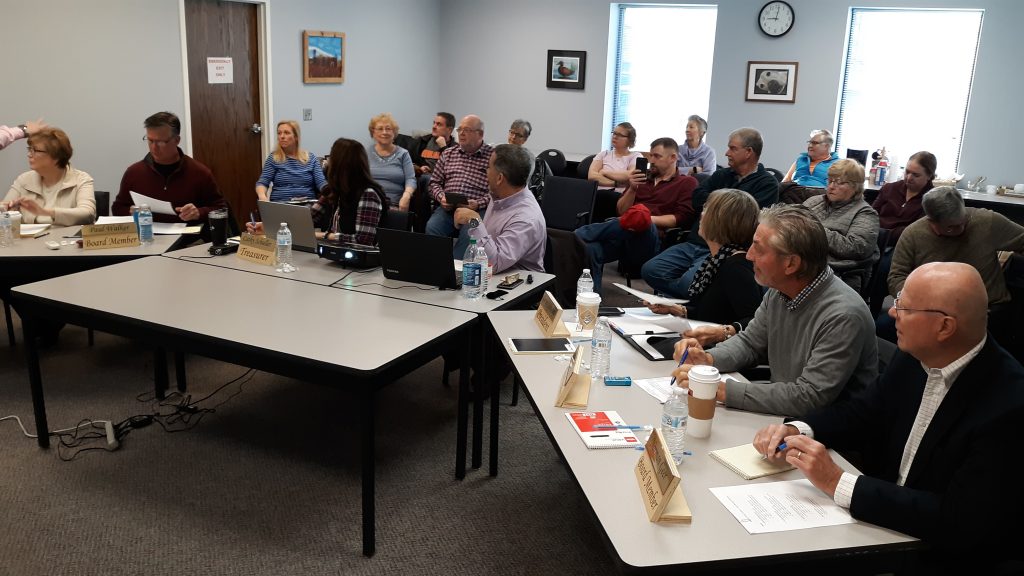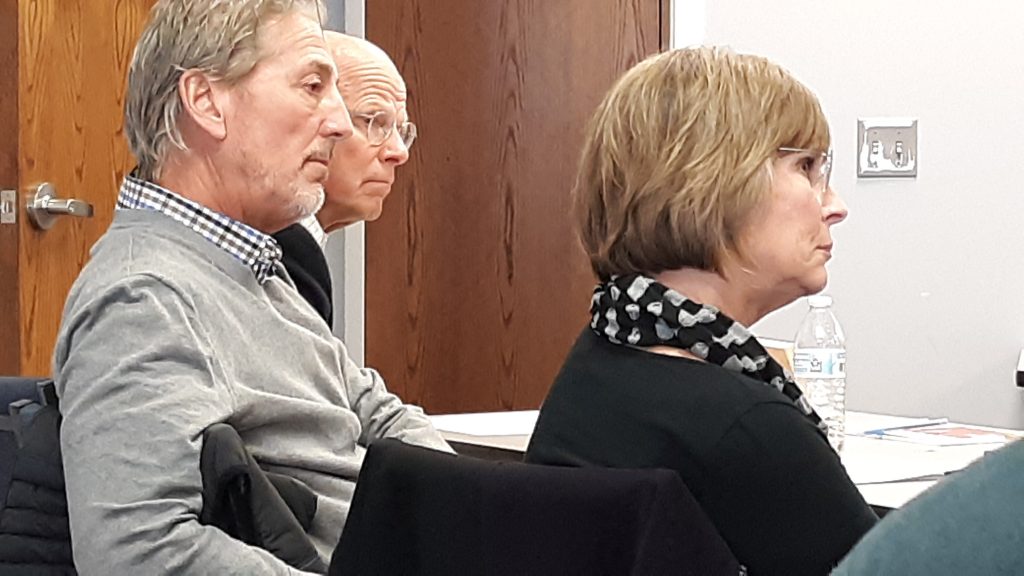By JAN LARSON McLAUGHLIN
BG Independent News
Bowling Green Board of Education finds itself wedged between a rock and a hard place.
The rock being that four levies are coming due, and a possible building bond issue, in the next three to five years.
The hard place being that efforts to consolidate those levies may be difficult for voters to digest.
The school board, superintendent and treasurer spent more than four hours on Saturday trying to get a grasp on the difficult climb ahead – and trying to find an option that voters will support.
Leading the work session was David Conley, the district’s financial consultant from Rockmill Financial Consulting, who tossed out numbers examining the differences between property tax and income tax, comparing Bowling Green to other districts, and studying the levy history for the district.
“This isn’t something that happened because people made mistakes,” Conley told the board. “It’s just a result of circumstances.”
But the result of those circumstances is made even more difficult because the clock is ticking.
The next opportunity to put a levy on the ballot is May. If the board decides to put an issue on in May, the filing deadline is Feb. 6. Though there was no consensus reached, the board will meet again on Thursday, Jan. 10, at 6 p.m., in the administrative offices, to continue the levy discussion.
Like many school districts, Bowling Green relies on levies that have time limits. The theory is that voters like to retain some control – rather than have continuing levies. And school boards, while preferring to have continuing levies, introduce time limited levies with the belief that voters will be more likely to support them.
But since school expenses always increase, rather than decrease, that puts districts in the difficult position of having to go back to the voters for money when the levies run out.
Bowling Green currently has three levies that are set to expire within the next three years:
- 4.2-mill current expenses levy, raising $2.4 million annually, ending in 2020.
- 1.6-mill emergency levy, raising $1 million a year, set to expire in 2020.
- 0.5 percent income tax, raising $3.4 million annually, ending in 2022.
Failure to at least renew those amounts “would be a disaster” for the district, Conley said.
Further complicating the situation is that in addition to those three renewals, the district also needs additional operating funds, plus is working toward some type of funding for building renovations or construction.
“This is a very complicated set of circumstances,” Conley said.
The district will soon need to secure some type of funding for its buildings, he said.
“Our facilities are sucking money out of our bank account,” Conley said. If allowed to continue, it “will screw up long-term plans for operations.”
The thought of asking the voters for funding five times in three years is more than daunting for the board.
“My gut tells me that five levies in three to five years is just suicide,” Conley said.
Board members agreed, with Bill Clifford sharing his concerns about “voter fatigue.”

So Conley suggested that the board examine ways to consolidate the levies – to minimize the number of times the district has to go on the ballot. The board ran through different scenarios of how that might be accomplished. But many of them added up to numbers that some members feared could scare off voter support.
Other districts have consolidated levies successfully, Conley said. For example, Canal Winchester managed to combine all its levies and pass a 14-mill levy for 10 years. No one, however, was thrilled with that prospect.
A big question is – how to explain the district’s dilemma to the voters?
“How do we try to describe this to the community,” Conley said. “The key is, the community needs to understand we are working through phases.”
Superintendent Francis Scruci stressed that the district needs to be able to explain the “whole blueprint” to the public.
“We need to start with the end in mind,” Scruci said.
Conley pointed out to the board that Bowling Green City Schools has not asked voters for new money since 2010.
“Which tells me you guys are controlling expenditures really well,” he said.
Most districts need to ask voters for additional funding every three years or so, Conley said.
“You aren’t mismanaging, and you aren’t wasting money,” he said. “Most school districts would have been asking for this money six years ago.”
Paul Walker pointed out that the district has been hurt by the loss of state funding.
“We’ve done our job,” and made cuts to keep operating, he said.
Conley also reinforced that while voters may prefer time-limited levies, the ongoing expenses encountered by school districts don’t decrease over time.
“The cost to operate a government never goes down,” he said. “The expenses are permanent. I can’t think of an expense that’s less than it was five years ago.”
The district will also be in need of new operating funds by fiscal year 2021.
“Every year you don’t do it, you need more because the hole gets deeper,” Conley said.
Conley also explained that when a levy expires and fails to be renewed, that money is lost immediately.
“Operating a government is kind of like steering a ship at sea,” he said.

Meanwhile, Bowling Green is looking at additional funding needed for teacher salaries and for more modular classroom units until school building issues are resolved.
Jill Carr pointed out that the district lost 25 teachers last year to districts that can pay more.
“We can’t continue that cycle,” she said.
Ginny Stewart agreed, saying teachers’ salaries are at risk if steady funding isn’t found.
But while continuing levies provide more security for school districts, some board members feared voters would balk at long-term funding.
Norm Geer said a time-limited levy would have a better chance of success.
“I think it will just be one more reason to vote no, if it’s continuing,” Clifford said. He also said that a levy for salaries is not a sure bet. “Not everybody believes that teachers are underpaid. Unfortunately, this day and age, that’s a reality.”
Looking back over the district’s history on the ballot, Conley showed Bowling Green has a 73 percent success rate.
“Our voter support trend is really, really strong,” he said. “You have community support.”
But the question is, will those voters also support continuing levy amounts, Conley asked.
Carr stressed that in order to make informed decisions, the board needs to know the recommendations from the community task forces about the future of the district’s buildings.
“We can’t drag this out,” she said.
Conley agreed, and said he has asked the architects coordinating the facilities task force to come up with a recommendation for the elementaries by mid-February, and possibly for the high school by mid-March. That would allow the finance task force to then work on funding models.
The board also spent a great deal of time talking about the taxing options for school districts. Currently the district gets the vast majority of its funding from three sources:
- 54 percent from property taxes.
- 33 percent from the state.
- 10 percent from income taxes.
Property tax revenue comes from both businesses and residents. In the Bowling Green district, 31 percent comes from businesses and 69 percent from residents and agricultural properties.
Divided further, residential taxes add up to roughly 59 percent; commercial, 24 percent; agricultural, 10 percent; industrial 6 percent; and public utilities, 1 percent. That public utilities number may grow if the district gets tax revenue from the Rover Pipeline.
There are two types of income taxes – though neither of them tax businesses.
Traditional income tax covers all income except Social Security, while earned income tax excludes those on fixed incomes. Businesses would benefit from either income taxes, and retired residents would benefit from earned income tax, Conley explained.
The downside of income taxes is that a smaller segment of the taxpayer base has to support the taxes since businesses are exempt. For that reason, income taxes are impacted more by recessions, Conley said.
Income taxes can only be raised by increments of a quarter percent. Bowling Green currently has a 0.5 percent income tax in place. That amount is at the low end of the income tax scale compared to neighboring school districts, Conley said.
Overall, Bowling Green is on the lower end of the tax scales for school districts, according to Conley.
“We’re starting to not keep pace with the other communities in the state of Ohio,” he said.
Though rare, a couple school districts in Ohio have been able to secure city income tax funds, Conley said.
Bowling Green may receive a boost in tax revenue from the new Rover pipeline going through the southern part of the district. The pipeline has 90 days to appeal the tax bill of $800,000 annually to the school district.
“I think we have to be careful applying that to our future income,” Clifford said.
Scruci reminded the board that a resolution has already been passed to put that money toward capital improvements – which Conley said was a wise decision.
Conley also pointed out that the tax revenue will drop every year as the pipeline depreciates.

